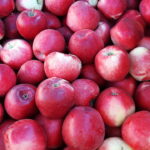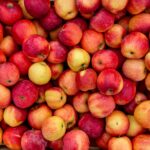Chilean apple size 'worst in 17 years', says exporter

As the Chilean apple harvest season draws to a close, growers have reported a difficult year marred by small fruit sizes and poor export market conditions. 
Exporter Los Lirios co-owner and commercial manager Cris Schittli told www.freshfruitportal.com the undesirable apple sizing came about from a combination of both natural and orchard management factors.
"This year we had a very difficult growing season in Chile because first we had the freeze, which killed the mother flower which normally produces the best sized fruit," he said.
"Then the growers were worried that they weren't going to have enough fruit on the trees, so they didn't do enough thinning. You have to do chemical thinning at the right times. So we had a heavy crop set."
The freezes in the spring were followed by an excessively hot summer, stunting the apples' growth and also impacting orchards due to a lack of rainfall in many areas.
"In Chile we had very hot weather leading up to the harvest which normally slows down the growth of the fruit a little bit. Then also in certain areas of Chile there was a drought," Schittli said.
"So I would say, in terms of sizing, this is probably the worst size year that I've seen in my 17 years in Chile. We've had a lot of small fruit, and obviously smaller fruit demands lower prices, so in that respect it's been a little bit of a challenging year."
The small fruit size has coupled with poor conditions in the Chilean apple industry's two largest export markets - the United States and Europe, which have both had higher stocks of local frui, leading them to import less.
According to figures by Chile's Agriculture and Livestock Service (SAG), the country's total apple exports to Europe fell 11.6% year-on-year this season, while to the U.S. East Coast they were down 9.7%.
"In the United States and Europe the apple stocks this year were high and some of the retailers won't switch over to imported fruit until the local crops are done, so our window is smaller," Schittli said.
According to Schittli, there is almost no domestic market in Chile for the fruit it grows, making foreign markets even more important than for other countries.
Despite the poor size of the apples, however, fruit quality has been pleasing, apart from some issues related to certain varieties.
"In terms of the quality of the fruit I would say it's been a good growing season. The condition of the fruit has been good, it's just more in terms of sizing," Schittli said.
"But we have had some quality problems in general a bit with the Granny Smith. With the hot weather, you tend to get problems with bitter pip, so Granny Smith season has been challenging in terms of condition for the industry."
Along with Granny Smith, Los Lirios also grows Chile's most popular variety, Royal Gala, and others including Pink Lady, Fuji, Red Delicious and Braeburn.
The Chilean harvest season normally lasts from the end of January through to May, and apples are most commonly grown between the Rancagua region in central Chile down to Angol further south.
Although this season has been a troubling one for Los Lirios and the Chilean apple industry in general, the long-term future is looking more positive as producers are constantly seeking new foreign markets.
"The important thing for us, in the case of the U.S. and the EU, is to not be so dependent on those markets. It's important for us to develop other markets, and right now we're starting to export more to India, China, and Latin America," Schittli said.
Schittli explained that Chile's favorable climate and excellent phytosanitary conditions gave it an advantage over other countries in the region when seeking addition export markets.
"In terms of climate, because we have a very Mediterranean climate here, we don't have a lot of phytosanitary issues so that gives us access to a lot more markets than our competition like Argentina or Brazil," he said.
Chile recently signed free trade agreements with India, China, and Korea, opening up big opportunities for the country's growers.
In addition, according to SAG the Chilean apple industry began exporting to Bangladesh, Singapore, Sri Lanka and Cambodia last year, while exports to India increased by 193% and by 32% to Taiwan.
Schittli said one trend he had witnessed over the last few months was growers trying out new apple varieties for the first time in an effort to broaden export opportunities.
"The variety that has grown the most in Chile has been the Pink Lady. It's a variety that has been growing faster than the consumption has been increasing in the main markets like Europe, so we need to find new ways to increase consumption in those places," he said.
The Los Lirios co-owner also explained he greatly enjoyed working in the fruit export business because of the diverse nature of the job.
"The fruit industry is challenging; you never know what to expect as every season's different. I would say that working in Chile is probably the best country to work in for this industry because we export to over 40 different countries," he said.
"Because of that you get the opportunity to meet a lot of different people, you get the opportunity to travel, and in general, I would say the people who work in agriculture are down to earth."
Photo: www.shutterstock.com














































